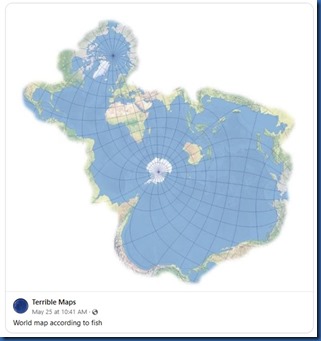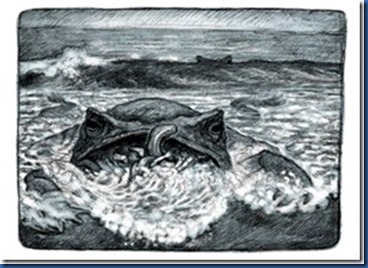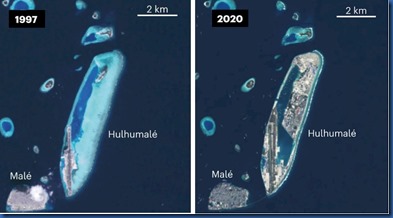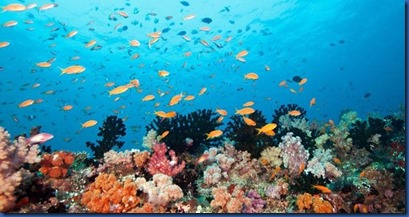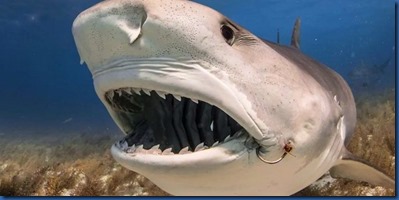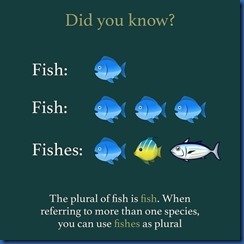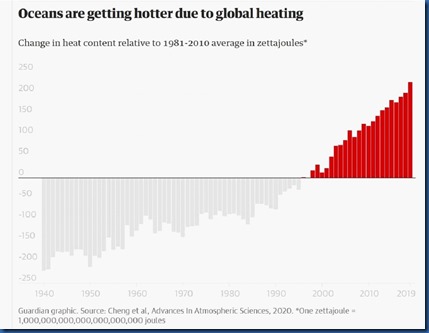I long been an a-fish-ionado of maps to provide a range of creative visualisations to guide humans, but someone has thoughtful crafted this cartographical guide for our piscatory residents and passers-through.
Is the “Sinking Maldives” the Maldives “Undertoad”?
The Maldives has been a poster child for the devastating impact of climate change. The image of an entire nation sinking into the depths of ocean captures the imagination like the tales of Atlantis. Newsweek recently published an article titled “We Are all Maldivians” which asserted:
- “If the Maldives sinks, it will also be time up for hundreds of millions of people who live in low-lying areas across the world.”
Article co-author former President Mohamed Nasheed is responsible for bringing the “sinking” meme to the world’s attention. It all started with a brilliant publicity stunt of holding a cabinet meeting underwater, and spread with Nasheed’s evangelical global advocacy for climate action.
First of all, let’s dispense with the semantic nicety that the Maldives are not “sinking” in the notion of their altitude getting close to the Earth’s centre. The land level is not dropping to any tectonic subduction, but rather the sea level is rising making the relative elevation above sea-level lower.
Nasheed’s piece cites a paper suggesting a sea-level rise of nearly 19mm per year, but recent data estimates that sea-levels are rising at a rate of 3.6mm per year [Royal Society]. This rise is the result of two main impacts of global warming: (a) melting Arctic land ice (eg. Greenland, Antarctica), and (b) expanding size of water at higher temperatures. The average elevation of the Maldives is 1600mm. So at the current rate of sea level rise, the Maldives won’t be mostly “sunk” for another 400 years. By which time, other problems like global famine and extreme weather events are much more likely to have decimated welfare more than the available land above water.
The ”sinking” calculations also assume that the Maldivians stand around passively and do nothing. They might not be able to unboil the ocean, but they can change the elevation of their country. In fact, despite rising sea levels of recent years, net Maldivian elevation has actually risen. Like the low lying ‘lands of nether” centuries before, Maldives has aggressively pursued efforts of terraforming which basically make islands out of ocean (as opposed to ocean out of islands when they sink) by dredging up landfill from the bottom of the ocean. In recent years, the country added over 432 hectares with the development of Huhumale island, and the president just recently announced the Ras Male project to add another 1,150 hectares (see photo below) with another major project in the Addu atoll aming to add 252 hectares. In the battle between rising seas and rising land, the land is winning.
Let me be clear…I am not denying climate change. The evidence that I have examined extensively does clearly show that (a) climate is changing, (b) this change’s speed is unprecedented in human history (limiting society’s ability to adapt in time), and (c) human activity (especially burning hydrocarbons) is the major contributor. Nor am I denying sea level rise. The oceans are rising and will continue to do so with climate change.
Why such pedantic distinctions? First of all, exacting accuracy matters in issues of science. By glossing over details, the climate activists expose themselves to the climate deniers who point out their minor errors and equate them to undermining all of science’s claims (the rhetorical term is “false equivalence”). Furthermore, people might end up fearing (and fighting) the wrong outcome. With limited political will (and hence public sector budget) to counter climate change, picking the right battles is important.
I am reminded of a passage from the book, “The World According to Garp” that an aquatic destination like the Maldives will appreciate:
- “He stood ankle-deep in the foam from the surf and peered into the waves, without taking a step, for the longest time. The family went down to the water’s edge to have a word with him. ‘What are you doing, Walt?’ Helen asked…’I’m trying to see the Under Toad,’ Walt said. ‘The what? said Garp.’ ‘The Under Toad,’ Walt said, ‘I’m trying to see it. How big is it?’ And Garp and Helen and Duncan held their breath; they realized that all these years Walt had been dreading a giant toad, lurking offshore, waiting to suck him under and drag him out to sea. The terrible Under Toad.”
What are the real “undertows” in the treacherous waters of climate change (as opposed to the “under toad” distractions)?
- Severe weather events – Even flooding in the Maldives is not from daily sea levels encroaching, but instead the result of surges from severe storms (eg. “Study highlights complex causes of Maldives flooding”. Warmer air and water temperatures intensify the concentration of humidity and energy in the atmosphere which create bigger and stronger storms.
- Death of the oceans – The death of ocean is the death of the Maldives since that country is 99.97% ocean. Its two main industries are tourism and fishing. And both depend on the ocean. Tourism first started entirely predicated on the allure of its ocean as a diver’s paradise. Over time, the appeal grew to more of an over water experience with water villas, over-water spas, over-water restaurants, etc. The ecological change in the marine life of the oceans will have a more dramatic effect on the lives of Maldivians more intensely and more immediately than its average elevation.
The aboriginal Maldives was mill-pond calm lagoons with crystal clear waters and teeming with colourful tropical fish darting amongst colourful corals. With warmer waters comes the bleaching and demise of the corals, and the knock-on drop in fish populations. And it’s not just underwater, but over water the increased temperatures bring increased winds frothing up the water and disturbing the sought after tranquility. Land reclamation might counter millimeter level rises in sea level, but not powerful and large ocean surges from increasingly powerful tropical storms. Like Walt’s ocean fear, people are fearing the “under toad” of “sinking” instead of the very real “undertow” of severe weather and dying coral reefs.
[POSTSCRIPT] These points underscored by this article “Nearly 1,000 disappearing islands in Maldives growing in size, surprising experts“:
- “If reports are to go by, when researchers analysed decades of aerial photos and satellite imagery, they came across an intriguing trend: Most islands have remained stable or even increased in area.”
The 8 Ds of a Great House Reef
World Oceans Day today celebrates the many wonders of the aquatic wonderland that defines the Maldives. But what defines a great destination for a house reef snorkel or exceptional dive site. One of the most frequently asked questions on the TripAdvisor Maldives Forum is which resort has the best house reef. But the obvious first question is “best in what way?” There are so many different qualities to a great reef. The best reef for you depends on how you weight each of these characteristics and how strong the reef is in each of them.
This is why my “House Reef Rating” on the Resort Profiles is so basic. It is hard to boil all of these considerations down into a single assessment.
I’ve been diving and snorkelling in the Maldives for two decades and have visited over 120 different islands (staying at over 116 different resorts), as well as other diving and snorkeling spots across the globe (Caribbean, Mediterranean, Red Sea, Galapagos, Indonesia).
To help break down the evaluation, I’ve come up with the 8 D’s of a great house reef…
- Density – Are the fish and coral just packed in like a Tokyo metro or scattered more widely? The best spots are like a grandma’s attic packed the brim with colourful and curious sights.
- Diversity – Is there a wide portfolio of sea life or is it a one-hit wonder? Maybe a spot presents a once-in-a-lifetime chance to swim with a manatee or see a whale migration, but are there side shows as well? The best spots are a veritable 3-ring circus of multiformity.
- Dazzle – Is there a ‘wow’ factor? The place to start here is the ‘Snorkel Safari Big 5’ (ie. Shark, Turtle, Ray, Moray, Lion Fish). Some resident creature, topological feature or other underwater sight that would make your jaw drop if your regulator or snorkel wasn’t in it.
- Distance – Is it easy to just jump in and you are on the reef in minutes? Easy accessibility is especially a part of the carefree, unencumbered, relaxed and spontaneous ethos of snorkeling culture, but access is a consideration for divers too.
- Degrees – How’s the water? Some amazing underwater sights are situated in less temperate areas. As a result, a wet suit is a advised and sometimes even a dry suit is needed. Whatever the underwater allure, chilly water is can be a distraction. Especially snorkeling, the ideal conditions are enjoying the sun on your back and nothing more to fuss with than a t-shirt.
- Decipherability – How far can you see? This is a big D word for ‘water clarity’. Clarity can vary due to currents, sea bed constitution, and ecosystem.
- Dependability – How reliable is the great experience? Are some excursions delights and other duds? A number of sites will have renowned ‘events’, eg. migrations, seasonal activity, feeding, but are only there certain times. The less predictable the less appealing.
- Drop-off – What is the shape of the underwater landscape? A reef ‘drop-off’ is ideal combining the inner reef lagoon shallows (where one can meander horizontally and even stand on sand – never coral! – and see fish in brightly lit sunlight) with a dramatic vertical dimension with deep water schools and marine animals. Pure deep water and pure shallows are never as good as a drop-off combo.
The TripAdvisor Maldives Forum itself also features a robust discussion of the subject og “What Do We Mean By A Great Reef”.
QI: Smile!
In honour of Oral Hygiene Day today…
Q: Who has the most teeth – an armadillo a garden snail, a horse, or a tiger shark
A: Shark?
Q: <buzzzz!> Actually a garden snail. Specifically, their 14,000 teeth (!) are more than 300 times more than a tiger shark (43). In fact, horses (44) and armadillos (74) have more teeth than a tiger shark.
While it varies by species, many sharks average around do average 30,000 teeth throughout their lifespan (as they discard them like toddlers throughout their lives)! That’s one approach to dental care.
QI: One Fish, Two Fish, and Fishes
Q: If what is the plural of fish if you are talking about different types of fish?
A: Fish?
Q: <<buzz>> No, “fishes”
No not “April Fool’s Day”, but “April Fish Day”. Yes, it’s a thing (no fooling!). So to mark the day, we have another QI fun fact that might just have you fooled.
Best of the Maldives: Ornate Eagle Ray – OZEN Maadhoo
The best of the “Best of the Maldives” posts are about discoveries that a rare, exciting and “wow”. And you don’t come any more so than the Ornate Eagle Ray we watched swimming in the water villa lagoon of OZEN Maadhoo. It was a fitting crescendo to a superb 2022 Tour. As Lori went out to the deck of our water villa she spotted this fellow cruising by. She grabbed her phone and followed him to the end of the jetty until she could get a good angle to shoot this footage. This was the first time we had ever seen this spectacularly mottled ray in over two decades of snorkeling, diving and jetty strolling in the Maldives. The Maadhoo Dive Manager Udo Goergen said in his many years there, he had only seen them a few times.
QI: Octopi in the Blue Yonder
QI: How does an octopus smell?
A: Depends if he’s had cabbage chilli for dinner (ba-dum-dum). *BUZZ*.
A: With its nose?
QI: *BUZZ* As this Harvard researcher determined, and like so many other activities in the octopus’ fascinating life, with its suckers (“Touch and taste? It’s all in the suckers”)
Happy Octopus Day! If an octopus seems otherworldly with all of these bizarre qualities, then maybe it more so than you realized according to Big Think – “Octopus-like creatures inhabit Jupiter’s moon, claims space scientist” With the Maldives otherworldly’ aquatic vistas, snorkeling with an octopus might be the closest thing you can get to experiencing an alien encounter in the zero gravity of space.
QI: Shark Sex
Sex…AND Sharks! Now that I have you attention!…
Q: How many penises does a male shark have?
A: One?
Q: BUZZZ. Nope. Two penises. “He uses only one at a time, depending on which side of the female shark he finds himself.” One is used for depositing and the other is used for “holding on”. Ducks famously have multiple vaginas (so they can choose which of the many male ducks who take her forcibly to actually sire her children). Sharks have multiple penises.
That’s not all they use to literally embrace their beloved. Male sharks also use their teeth used to hold onto female shark (so much so that “female sharks tend to have thicker skins than males and bigger bodies in order to withstand the results of a male shark trying to hang onto her with his teeth” (up to 3x thicker). Now THAT’s a love bite!
Q: Since sharks are fish and not mammals, how many ways can sharks give birth?
A: One (laying eggs)?
Q: BUZZZ. A number of shark are indeed oviparous (lays eggs), but a number of species are viviparous (give birth live).
A: So two??
Q: BUZZZ. Some shark species are actually ovoviparous meaning that the eggs hatch in the oviduct within the mother’s body and that the egg’s yolk and fluids secreted by glands in the walls of the oviduct nourishes the embryos.
Montastraea of the Maldives and More
View this post on Instagram
Another way to virtually enjoy the Maldives reefs are with the fabulous photos shared on Instagram. So I’ve curated another collection of coral close-ups which highlight the mesmerising patterns of these carbonate creatures.
View this post on Instagram
View this post on Instagram
View this post on Instagram
View this post on Instagram
View this post on Instagram
View this post on Instagram
View this post on Instagram
View this post on Instagram
View this post on Instagram
View this post on Instagram
View this post on Instagram
View this post on Instagram
Putting Ocean Warming into Perspective
Few places provide the perspective the Earth’s vastness as effectively as standing on the seashore and gazing out on the vast expanse of the ocean. The level horizon provides an uninterrupted vista of the planet allowing the view to extend miles and miles (well, 3 miles about). A dip into this immensity adds the dimension of depth as you realise that this body of water plummets to fathoms below. In fact, the lowest point down in the ocean (Challenger Deep 36,200 feet) is deeper than the highest point up on land (Mount Everest 29,029 feet).
This immensity cloaks the blue planet in not just an aquatic wonderland, the birthplace of life and countless resources, but it regulates the world’s climate significantly. It absorbs and releases heat and water constantly. And with the inexorable release of Anthropocene carbon into the atmosphere and the consequential inching up of average temperatures, the oceans are doing their bit to absorb both.
The problem is that when the oceans absorbs carbon it makes the seawater more acidic which makes it less hospitable for a lot of its creatures. Also, when it absorbs the heat, it raises the water temperature which makes it less hospitable for the one of the pillars of the marine food chain – the coral reefs. The result is the widely reported bleaching and dying of the reefs. Over the two decades we have been visiting the Maldives, we have applauded the destination growing in many exciting ways, but each year (especially recently) we despair at the painful shrinking of the living coral primarily due to the warming sea temperatures.
In the Maldives, the reefs are not just foundation to the ecosystem, but the entirety of the county’s very being. As such, the country has been on the vanguard of campaigning for eco-sustainability and cutting carbon emissions. With the global prominence of Time’s Person of the Year Greta Thunberg and the impassioned television series by famed naturalist David Attenborough “Life on Our Planet”, the scale of carbon impact is getting a higher profile than ever.
But just how big is the impact right now? Forget all of the controversial models and forecasts. Forget the graphs showing tonnes of carbon emitted (as few of us are chemistry experts to know what all that carbon really means). Let’s just look at the actual, observed real world impact today of that carbon and climate change with a easily obtained and verified measurement – the temperature of the ocean.
I’ve happened upon a couple of illustrations of ocean temperature increase recently which prompted this post. The first from the Futurism website noted that
- “After analyzing data from the 1950s through 2019, an international team of scientists determined that the average temperature of the world’s oceans in 2019 was 0.075 degrees Celsius (.135 degrees Fahrenheit) higher than the 1981–2010 average…The amount of heat we have put in the world’s oceans in the past 25 years equals to 3.6 billion Hiroshima atom-bomb explosions. That averages out to four Hiroshima bombs’ worth of energy entering the oceans every second for the past 25 years. But even more troubling, the rate isn’t holding steady at that alarming figure — it’s increasing.”
But a possibly even more dramatic number and comparison is the simple quantification of the energy that the ocean has absorbed – an accelerating at average of 10 zetta-joules per year(and last year was over 200 zetta-joules added). ZETTA joules. You don’t know what that is? Not surprising since it is such a big number there really aren’t many things in the universe to apply it to. A “zetta” is “10^21” (1 with 21 zeros after it).

